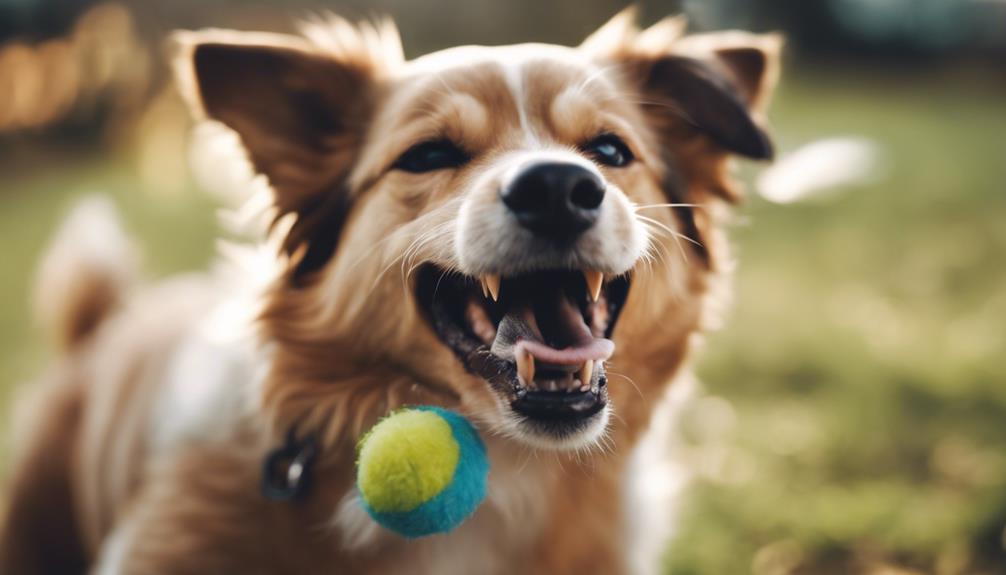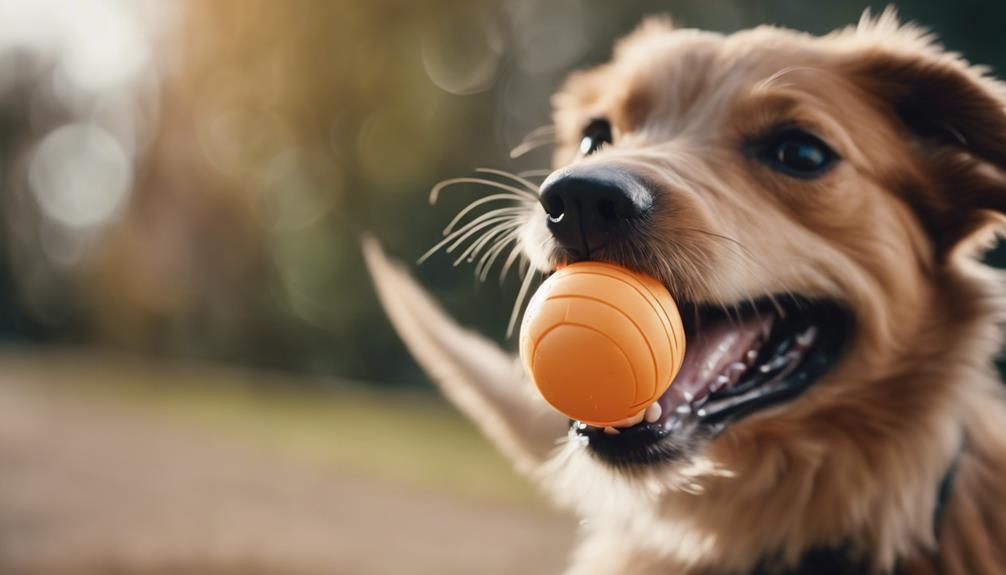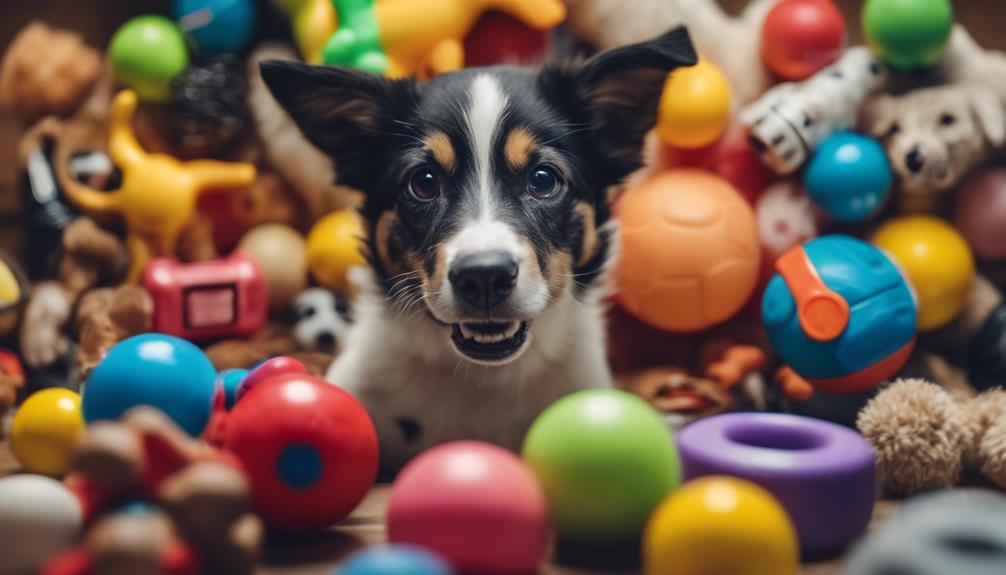Have you ever wondered why dogs are so drawn to squeaky toys, their tails wagging with joy as they pounce on these seemingly simple playthings?
Well, there's more to it than meets the eye. Understanding the psychology behind a dog's fascination with squeaky toys may offer insights into their natural instincts and emotional needs.
So, why exactly do dogs find these toys so captivating? Let's explore the intriguing reasons behind your pup's love for squeaky toys and what they might be seeking to achieve through this playful behavior.
Key Takeaways
- Dogs are attracted to squeaky toys due to their resemblance to distressed prey sounds.
- Play behavior with squeaky toys stimulates cognitive functions, social skills, and overall well-being.
- Choose safe, durable toys and supervise play to prevent accidents and ensure pet safety.
- Providing a variety of toy types, including interactive and comfort toys, enriches playtime and prevents boredom.
Sound Preference in Canines
Dogs exhibit a natural inclination towards specific sounds, indicating a distinct sound preference in canines. This preference stems from their ancestral hunting instincts, as high-pitched sounds resembling distressed prey trigger their predatory drive.
The squeaky noise produced by toys mimics the sounds of injured animals, appealing to dogs' primal instincts. Research suggests that canines are more responsive to higher-pitched sounds, associating them with friendliness and playfulness.
This sound preference explains why squeaky toys are so captivating to dogs, as they fulfill a deep-rooted need for interaction and excitement. Understanding this aspect of dogs' behavior can help owners choose toys that align with their pets' innate preferences, providing them with both entertainment and mental stimulation.
Safety Tips for Squeaky Toys
When selecting squeaky toys for your pet, ensure they're made of durable materials that can withstand chewing and play. Look for toys labeled as safe for pets and avoid small parts that could be easily ingested.
Regularly inspect the toys for any signs of damage or wear and tear, and replace them if necessary to prevent choking hazards. Supervise your pet while they play with squeaky toys, especially if they're aggressive chewers.
If your dog starts tearing apart the toy, intervene immediately to prevent them from swallowing any pieces. Prioritize your pet's safety by choosing toys that are appropriate for their size and play style to ensure a fun and safe playtime experience.
Understanding Canine Play Behavior

Exploring the dynamics of play behavior in canines reveals insights into their social interaction and cognitive development. Dogs engage in play for various reasons, reflecting their natural instincts and social bonds:
- Socialization: Play helps dogs develop social skills, learn boundaries, and communicate with other animals.
- Mental Stimulation: Canine play behavior stimulates cognitive functions, problem-solving abilities, and creativity.
- Physical Exercise: Playful activities contribute to a dog's physical health, promoting agility, strength, and coordination.
- Emotional Well-being: Play behavior can enhance a dog's emotional state, reducing stress, anxiety, and boredom while fostering a sense of happiness and fulfillment.
Alternatives to Squeaky Toys
While exploring options beyond squeaky toys for canine playtime, consider incorporating interactive puzzle games to engage your furry companion mentally and physically. Puzzle toys, such as the Kong Wobbler, provide mental stimulation as dogs work to access treats, promoting problem-solving skills and preventing boredom.
Additionally, toys like the Snuggle Puppy can offer comfort to dogs dealing with fear or anxiety, providing a soothing companion during stressful times. Snuffle mats are another excellent alternative, encouraging dogs to use their noses to search for hidden treats, tapping into their natural foraging instincts.
Behavioral Insights on Dog Toys

Understanding the behavioral cues and preferences of dogs can provide valuable insights into their interactions with different types of toys.
- Texture: Dogs may prefer toys with different textures for chewing or carrying around.
- Size: Dogs often enjoy toys that are easy to hold or carry in their mouths.
- Durability: Toys that withstand rough play are favored by many dogs.
- Interactive Elements: Toys with treats hidden inside or puzzles to solve can keep dogs mentally stimulated.
Ensuring Enrichment in Playtime
To ensure dogs' playtime is enriching, provide a variety of engaging toys that cater to their preferences and stimulate their mental and physical abilities. Offering a mix of interactive toys, puzzle toys, and comfort toys can keep dogs stimulated and entertained. Interactive toys encourage physical activity and engagement, puzzle toys provide mental stimulation and problem-solving opportunities, while comfort toys offer emotional support and relaxation. By rotating these types of toys regularly, owners can prevent boredom and promote overall well-being in their furry companions.
| Interactive Toys | Puzzle Toys | Comfort Toys |
|---|---|---|
| Rope toys for tug-of-war | Treat-dispensing toys | Plush toys for cuddling |
| Frisbees for outdoor play | Interactive feeders | Calming beds or blankets |
| Balls for fetch games | Hide-and-seek toys | Stuffed animals with heartbeat simulation |
Privacy Policies and Data Handling

To ensure transparency regarding user data, the company implements strict privacy policies and practices secure data handling procedures. When it comes to privacy policies and data handling, the following key points are essential:
- Data Processing by Us and Partners
- Information Storage and Access
- Personalized Advertising
- Content Customization
These measures are put in place to safeguard user information and provide a secure environment for data processing. By adhering to these policies, the company aims to prioritize user privacy and maintain trust in its data handling practices.
Conclusion
In conclusion, understanding why dogs like squeaky toys can help enhance their play experiences and emotional well-being.
By recognizing the instinctual responses triggered by high-pitched sounds and following safety tips for toy selection, pet owners can ensure their furry companions have a fun and enriching playtime.
With alternatives available and a focus on providing mental stimulation, dogs can enjoy a variety of toys that cater to their natural behaviors and preferences.
Remember, a happy pup is a playful pup!




